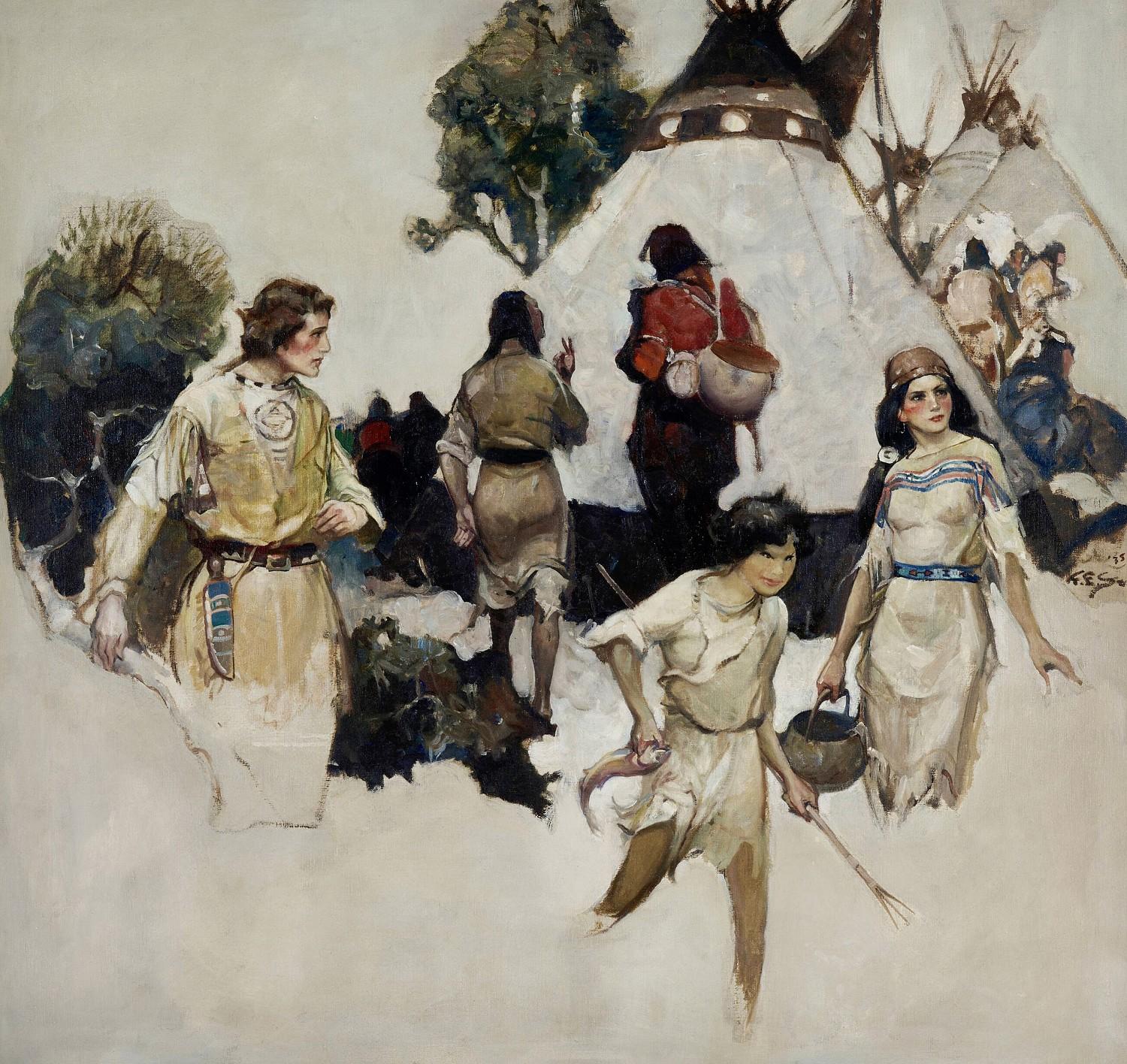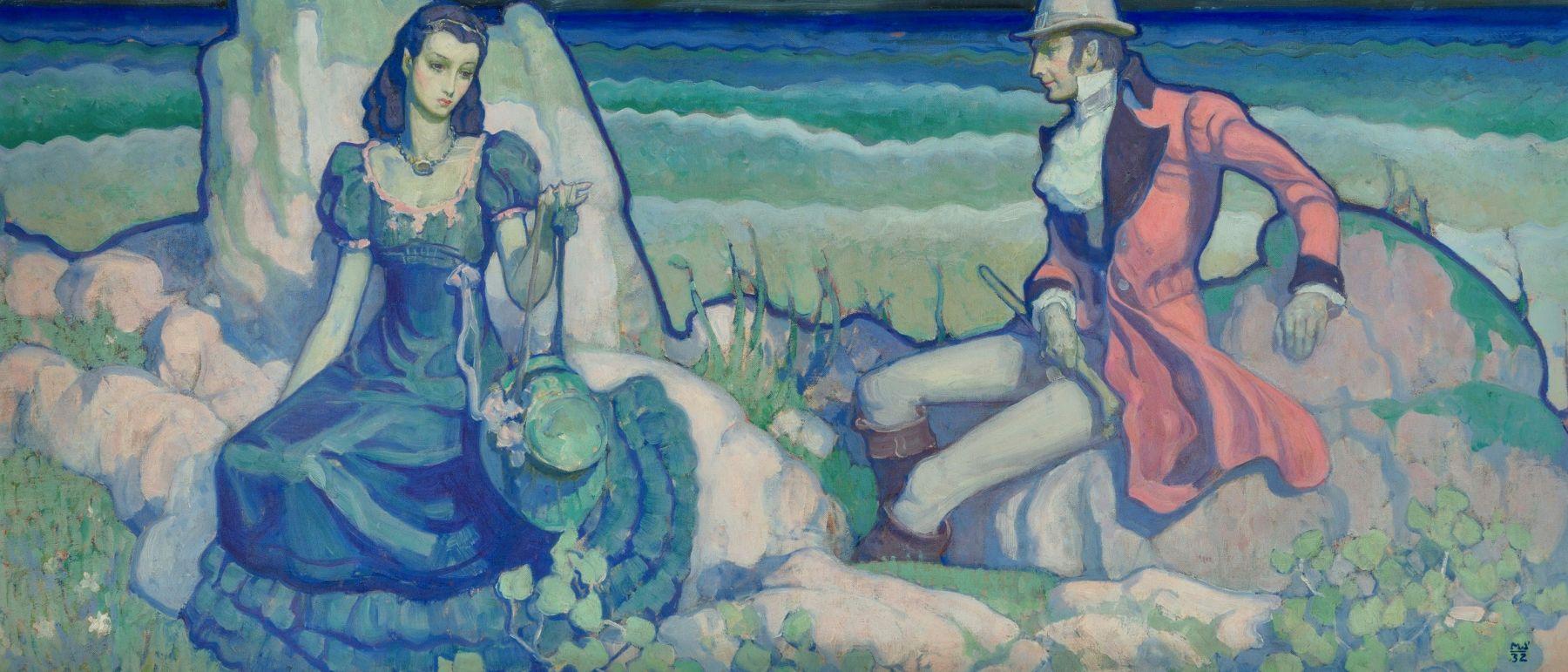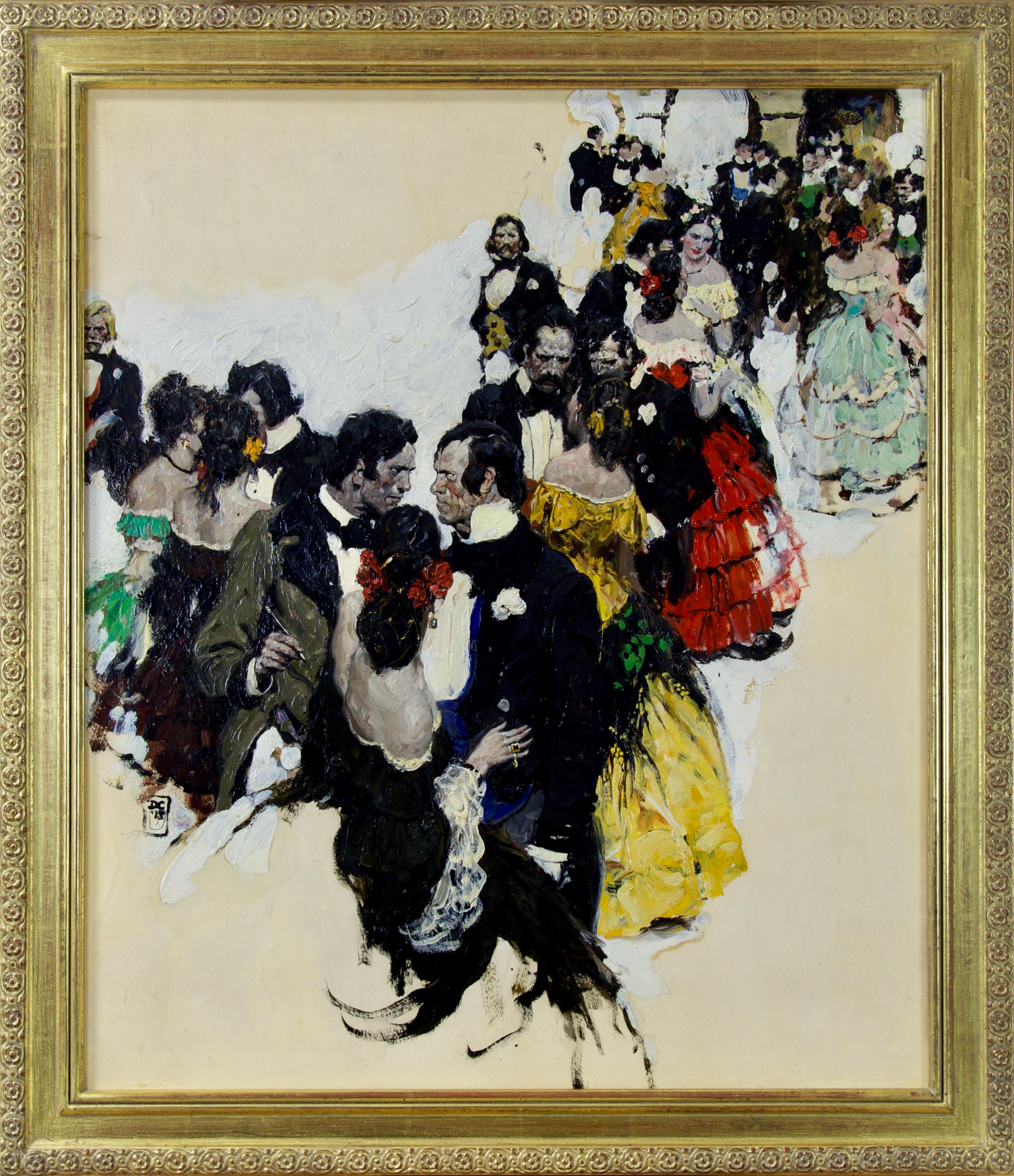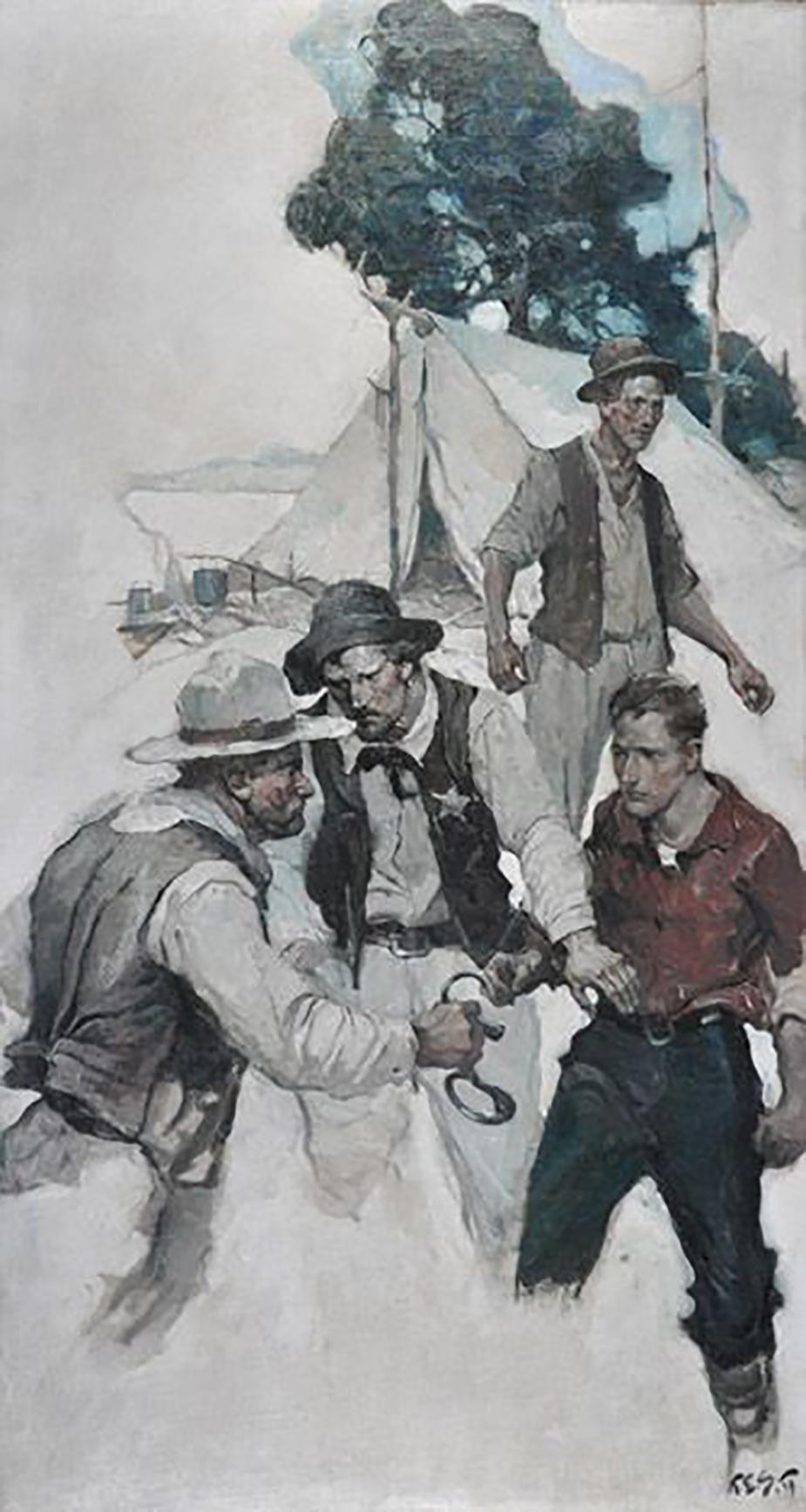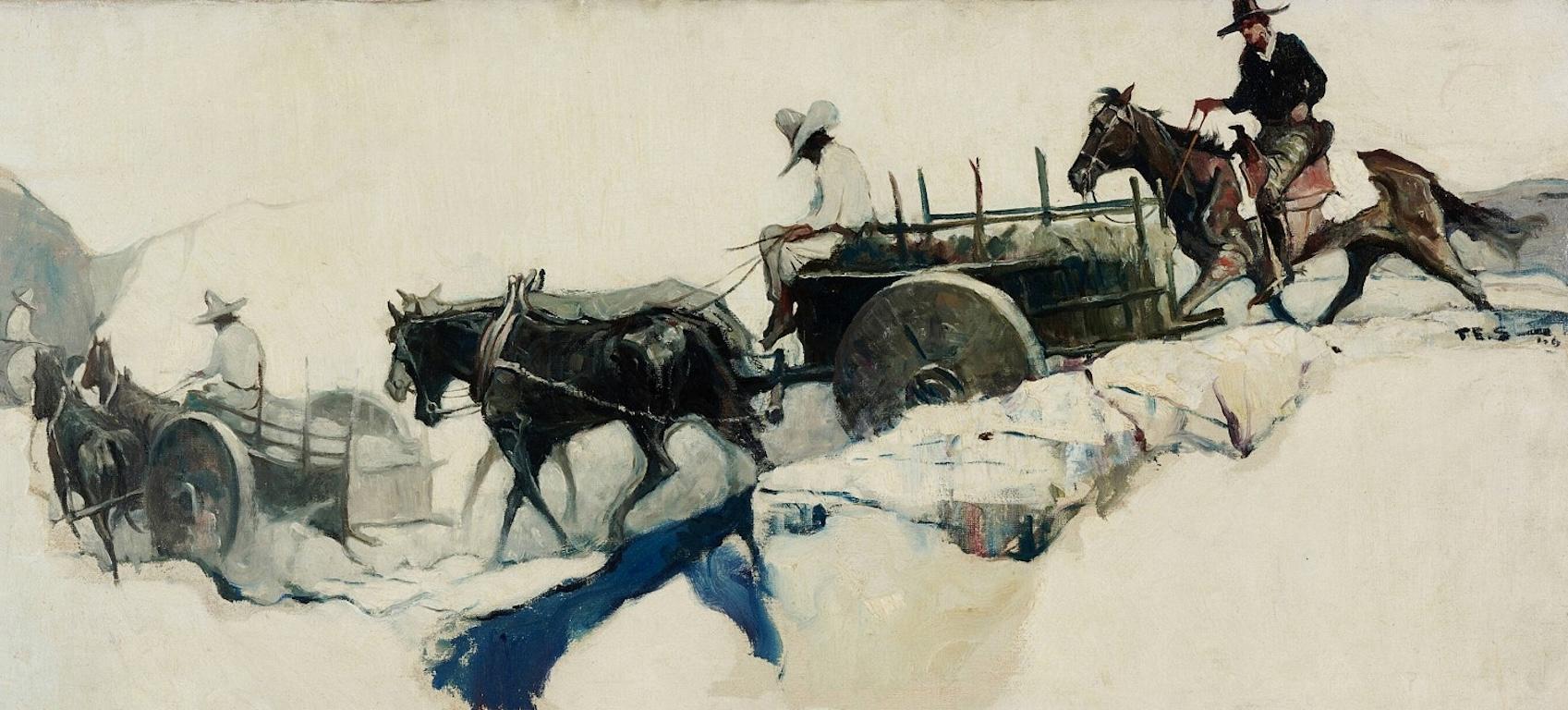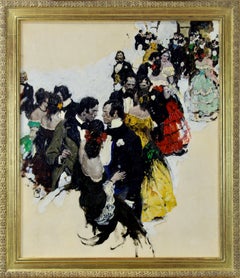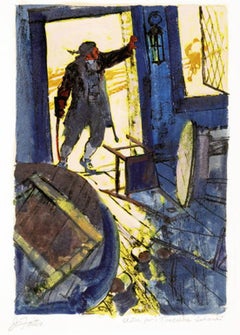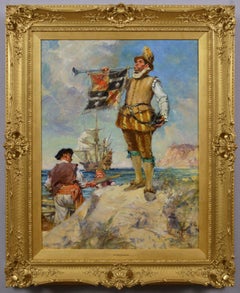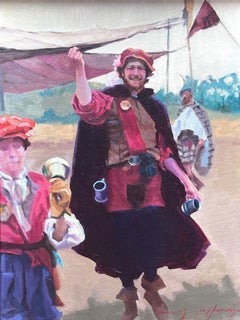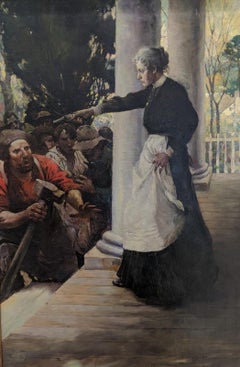Items Similar to The Scarlet Cockerel interior book illustration
Want more images or videos?
Request additional images or videos from the seller
1 of 6
Frank SchoonoverThe Scarlet Cockerel interior book illustration1931
1931
$36,000
£27,657.47
€31,778.11
CA$50,638.46
A$56,890.04
CHF 29,725.13
MX$694,369.55
NOK 377,422.37
SEK 355,263.65
DKK 237,140.11
About the Item
Medium: Oil on Canvas Laid on Panel
Sight Size 30.00" x 21.00;" Framed 36.50" x 27.50"
Signature: Signed and Dated Lower Right: F. E. Schoonover / 31
"I began to notice the mysterious actions and the frequent journeys that Michel Barre made into the south." The Scarlet Cockerel interior book illustration, 1931
LITERATURE:
C.M. Sublette, The Scarlet Cockerel, New York, 1931, n.p., illustrated.
- Creator:Frank Schoonover (1877 - 1972, American)
- Creation Year:1931
- Dimensions:Height: 30 in (76.2 cm)Width: 21 in (53.34 cm)
- Medium:
- Period:
- Condition:
- Gallery Location:Fort Washington, PA
- Reference Number:Seller: 39251stDibs: LU38435926092
About the Seller
5.0
Recognized Seller
These prestigious sellers are industry leaders and represent the highest echelon for item quality and design.
Gold Seller
Premium sellers maintaining a 4.3+ rating and 24-hour response times
Established in 1995
1stDibs seller since 2016
129 sales on 1stDibs
Typical response time: 4 hours
- ShippingRetrieving quote...Shipping from: Fort Washington, PA
- Return Policy
Authenticity Guarantee
In the unlikely event there’s an issue with an item’s authenticity, contact us within 1 year for a full refund. DetailsMoney-Back Guarantee
If your item is not as described, is damaged in transit, or does not arrive, contact us within 7 days for a full refund. Details24-Hour Cancellation
You have a 24-hour grace period in which to reconsider your purchase, with no questions asked.Vetted Professional Sellers
Our world-class sellers must adhere to strict standards for service and quality, maintaining the integrity of our listings.Price-Match Guarantee
If you find that a seller listed the same item for a lower price elsewhere, we’ll match it.Trusted Global Delivery
Our best-in-class carrier network provides specialized shipping options worldwide, including custom delivery.More From This Seller
View All""I Had Tried Several Times to Meet Dawn Woman" Story Illustration
By Frank Schoonover
Located in Fort Washington, PA
Story illustration for "Beaver Woman's Vision" by James Willard Schultz, published in The American Boy, July 1935, pg. 5 The White Buffalo Robe, Schutz, pg. 30
Literature:
Schoono...
Category
1930s Figurative Paintings
Materials
Canvas, Oil
Peggy O'Neil, Redbook Magazine Interior Illustration, 1932
By Mead Schaeffer
Located in Fort Washington, PA
Illustration for “Women America Remembers: Peggy O’Neil” by Arthur D. Howden Smith for The Red Book Magazine, published March 1930, illustrated pages 20-21.
This painting by Mead Schaeffer depicts a romantic encounter between Peggy O'Neil and her first husband, John Timberlake. The accompanying caption reads: "It was inevitable that Peggy should fall in love—and she did, with John Timberlake, who had little besides his face to recommend him." It was created in 1930 for the third installment of The Red Book Magazine’s “Women America Remembers” series, which features stories of women famous for “personality, beauty, wit or audacity, or because of the tragedy left in their train.”
Margaret ("Peggy") O'Neil Eaton remains a figure of historical intrigue, primarily for her central role in the "Petticoat Affair," a significant political scandal during Andrew Jackson's presidency. The circumstances surrounding Peggy’s marriage to John Eaton, occurring shortly after the death of her first husband, John Timberlake, and her family’s background as tavern-keepers, coupled with her perceived impudent personality, subjected her to intense social scrutiny in Washington D.C. Upon John Eaton's appointment as Secretary of War, Peggy faced social ostracism led by Floride Calhoun, wife of Vice President John Calhoun...
Category
1930s Figurative Paintings
Materials
Canvas, Oil
"We Went Into Camp"
By Frank Schoonover
Located in Fort Washington, PA
Medium: Oil on Canvas
Signature: Signed Lower Right
Category
Mid-20th Century Figurative Paintings
Materials
Canvas, Oil
Periwinkle House, The Red Book Magazine interior illustration
By Dean Cornwell
Located in Fort Washington, PA
Story illustration for “Periwinkle House” by Obie Read, published in The Red Book Magazine, July 1920, page 39.
The story is described by Red Book as “A Romance of the Mississippi R...
Category
Early 1900s Paintings
Materials
Oil
"The Rustlers of Silver River, " Story Illustration for Country Gentleman
By Frank Schoonover
Located in Fort Washington, PA
Medium: Oil on Canvas
Signature: Signed Lower Right
See Here Rollins
1929 Story, The Rustlers of Silver River by Zane Grey. Country Gentleman Magazine, Jan...
Category
1930s Figurative Paintings
Materials
Canvas, Oil
"He Had Found His Quarry–Now the Question Was–What To Do" Western Illustration
By Frank Schoonover
Located in Fort Washington, PA
“The Gun-Runners” by Edwin Cole, published in The Youth’s Companion, May 6, 1926, pg. 343. Western illustration
Literature: Schoonover, Smith & Dean 1450
Artwork Dimensions: 17.5...
Category
1920s Figurative Paintings
Materials
Canvas, Oil
You May Also Like
Illustration Treasure Island
By John Philip Falter
Located in Miami, FL
Original Preliminary Book Illustration
Treasure Island by Robert Louis Stevenson,
MacMillan, 1963
At the Admiral Benbow
Mixed-media on board
9.5in. x 6in. (sight size)
Signed lower left: J. Falter
Inscribed lower left: "Sketch for Treasure Island"
Morris Weiss collection...
Category
1960s Contemporary Figurative Drawings and Watercolors
Materials
Mixed Media
Historical genre oil painting of a royal messenger
By Arthur David McCormick
Located in Nr Broadway, Worcestershire
Arthur David Mccormick
Irish/British, (1860-1943)
The Royal Fanfare
Oil on canvas, signed
Image size: 23.5 inches x 17.5 inches
Size including frame: 31.5 inches x 25.5 inches
Provenance: Frost & Reed
A wonderful historical painting of a trumpeter signalling the arrival of the Royal Ship by Arthur David Mccormick. The Herald, dressed in yellow livery plays a fanfare as the others prepare for the arrival of the Royal boat.
Arthur David Mccormick was a painter of historical, naval, and genre scenes who was born in Coleraine, Ulster in Northern Ireland on 14 October, 1860. After attending his local school, he studied at the Government School of Design in Belfast. He then moved to London where he enrolled at the Royal College of Art in 1883. To support his studies he also contributed drawings and designs to the English Illustrated Magazine and Illustrated London News.
McCormick made his debut at the Royal Academy in 1889 continuing to exhibit there throughout his life. He exhibited at the Royal Society of British Artists from 1890, becoming a member in 1897 and at the Royal Institute of Oil Painters, Royal Institute of Painters in Watercolour and the Alpine Club Gallery. As well as being a yachtsman he also took an interest in mountaineering and on 5 February 1892 joined Sir Martin Conway’s expedition to the Karakoram Himalayas as their artist. He produced more than 300 illustrations, mainly watercolour paintings which appeared in Conway's 1894 book ‘Climbing and exploration in the Karakoram Himalayas’. He later published his own book ‘An artist in the Himalayas’ using his pencil sketches from the expedition.
He married Helen MacAlpine-Woods at Strean Church, Newtonwards, Ireland on 25 September, 1894. The couple lived at 58 Queens Road, St John’s Wood where their only daughter Helen Gladys was born in 1895. During the same year, he travelled with Clinton T. Dent’s on his expedition to the Caucasus Mountains, producing a number of sketches and drawings. He was also made a fellow of the Royal Geographical Society in 1895 in recognition of his work.
After the death of his wife in 1899, he remained at Queens Road from where he continued to work and exhibit, employing a governess to help with his daughter. When the Ulster Arts Club was formed in 1902 he was among its first honorary members. In 1905, he was made a member of the Royal Institute of Oil Painters and in 1906 became a member of the Royal Institute of Painters in Watercolours. On 7 May, 1906 he married Helen (Nellie) Elizabeth K Laker, his daughter’s governess. In addition to painting he also produced illustrations for many books mostly related to travel and adventure. He was employed by John Player & Son in 1927 to paint the sailor's head and shoulders for their cigarette packets as well as producing a number of oil paintings which were used as promotional posters.
Around 1934 he moved to 53 Colet Gardens, Hammersmith, where he spent the rest of his life. He died in London, aged 83, on 12 March, 1943. Examples of his work can be found at the Alpine Club Collection, Coleraine Museum, Grundy Art Gallery, Imperial War Museum, National Museum of Wales, National Museum of the Royal Navy Portsmouth, Newport Museum, The Box Plymouth and Williamson Art Gallery.
Presentation: The work is housed in its original gilt frame which is in excellent condition. The reverse bears a label for Frost & Reed and is dated 5 November 1936. Frost & Reed is a well known fine Art Gallery, frame makers and fine art publishers founded in Bristol in 1808 by William Hill. The business was bought by John Frost in 1859 who ran it until his death in 1875. His nephew Walter Frost took over the business and in 1881 brought in William Reed...
Category
Early 20th Century Figurative Paintings
Materials
Canvas, Oil
'Renaissance Fair' by Don Hatfield - Vibrant Renaissance Fair Scene Painting
By Don Hatfield
Located in Carmel, CA
Don Hatfield’s 'Renaissance Fair' is a vibrant example of American Impressionism, showcasing his ability to capture lively scenes with rich color and fluid brushstrokes. This framed ...
Category
20th Century American Impressionist Figurative Paintings
Materials
Canvas, Oil
A Daughter of the South
By Frank Schoonover
Located in Greenville, DE
Number 382 in the Schoonover raisonné. Signed and dated 1909. Beautifully reframed in custom 23 karat gold leaf frame.
Category
Early 1900s Realist Figurative Paintings
Materials
Canvas, Oil
Spanish Tavern
By Dean Cornwell
Located in Miami, FL
There is no one alive that can paint and draw like Dean Cornwell. How can that be? They do not train artist the way they did. He was Normal Rockwell's ...
Category
1920s American Impressionist Figurative Paintings
Materials
Oil
Keying Up - The Court Jester
By William Merritt Chase
Located in Fairlawn, OH
Keying Up - The Court Jester
Etching with drypoint, 1879
Signed in the plate lower left corner (see photos)
Proof before engraved title and engraved names
Printed on thin light golden Japanese tissue paper
In the final state, with engraved titled and typeface engraved artist’s signature below the image
Condition: excellent
Plate size: 6-5/8 x 4-1/4"
According to Pisano, this image was very popular during Chase’s life. It is based on his famous painting, Keying Up-The Court Jester, in the collection of the Pennsylvania Academy of Fine Arts. The painting was created in Munich during the artist’s studies there. It was exhibited in the 1876 Centennial Exhibition in Philadelphia where it won a Medal of Honor and helped establish the artist’s reputation as a leading American painter.
Chase, always conscious of self promotion, created the etching and had numerous impressions printed. He sold them for a modest price to increase his fame. The etching was later published in Sylvester R. Koehler, American Art Review, September 1878. It was for this American Art Review printing that the engraved titled and type face signature below the image were added to the plate.
This example was part of a group of impressions that came down in the Chase family via his daughter Dorothy Bremond Chase, his third daughter. They were acquired at auction in a single auction lot, housed in a paper board folder. The consignor was Associated American Artist’s as they were liquidating their stock prior to closing the gallery.
Dorothy was the subject of Chase’s painting, My Little Daughter Dorothy. C. 1894, in the collection of the Detroit Institute of Arts as well as numerous other portraits of her.
Reference: Pisano/Bake, Volume 1, Pr. 3, illustrates the rare 1st state, this being a 2nd state before any other the engraved title and Chase's name in the bottom margin which are found in the third state.
Artist bio in file (Chase)
In 1883 Chase was involved in the organization of an exhibition to help raise funds for a pedestal for the Statute of Liberty. The exhibition featured loans of three works by Manet and urban scenes by the Italian Impressionist Giuseppe de Nittis. Both artists influenced Chase's Impressionistic style that gave rise to a series of New York park scenes. It is also thought that he was influenced by John Singer Sargent's In the Luxembourg Gardens (1879) which was exhibited in New York at this time. Indeed, Chase had met Sargent in Europe in 1881, the two men becoming lifelong friends with Sargent painting Chase's portrait in 1902.
On another European trip in 1885, Chase met James McNeill Whistler in London. While Whistler had a reputation for being difficult, the two artists got along famously and agreed to paint one another's portrait. Eventually, however, Whistler's moods began to grate with Chase who wrote home stating "I really begin to feel that I never will get away from here". For his part, Whistler criticized Chase's finished portrait and, according to Hirshler, "complained about Chase for the rest of his life". While no record exists of Whistler's portrait of Chase; Chase's portrait of Whistler remains a well-known piece in his oeuvre.
In 1887 Chase married Alice Gerson, the daughter of the manager of a lithography company. Though some fifteen years his junior (Chase was 37), he had known Alice for some time through her family's devotion to the arts. The pair, who would enjoy a happy marriage with Alice in full support of her husband's career, settled initially in Brooklyn where their first child was born. The couple would parent six daughters and two sons and it was only his family that could rival his devotion to his art. Indeed, Chase often combined his two loves by painting several portraits of his wife and children in Brooklyn parks before the couple relocated to Manhattan.
Later Period
Between 1891 and 1902, Chase and his family spent their summers at a purpose-built home and studio in Shinnecock Hills, a close suburb of the upmarket town of Southampton on the south shore of Long Island (roughly 100 miles east of New York). Chase set up, and taught two days a week, at the nearby Shinnecock Hills Summer School of Art which benefitted from the financial backing of local art collectors. It was at Shinnecock that Chase, taken in by the region's striking natural surroundings, painted several Impressionistic landscapes. As Bettis put it, "There, among the dunes, in the bright sunlight and sea air his painterly impulse was given free sway, and he produced some of his freest and loveliest work". His passion for the area was so felt he even gave his daughter Hazel the middle name of Neamaug, in honor of the rich Native American history of Shinnecock. Chase was equally focused on the students that came to the School and who he encouraged to paint in the modern plein air style favored by the French Impressionists.
Although Chase was making a name for himself as an Impressionist, he never abandoned his commitment to the sombre tones and academic tropes he had learned in Munich, though these he reserved for his portraits, and for his series of striking still lifes featuring dead fish. Chase was in fact a successful society portraitist - he painted fashionable women for a fee of $2,000 - and would paint his students as "samples" which he then donated to leading art institutions (such as Lady in Black (1888) which he donated to the Metropolitan Museum in 1891).
In 1896, facing financial difficulties, Chase flirted with the idea of giving up his teaching in New York and traveled with his family to Madrid where he developed a passion for bullfighting. Chase returned however to Shinnecock in June to teach his yearly summer art class, and in the fall of that year, established his own art school in Manhattan: the Chase School which was modelled on the Académie Julian in Paris. Chase lacked business savvy, however, and the Chase School lasted only two years before it was placed under new management. It continued as the New York School of Art (changed to Parsons School of Design starting 1941) with Chase as head the School for eleven more years. Chase also taught during this period at the Pennsylvania Academy of Fine Arts.
In 1902, following the premature death of his friend John Twachtman, Chase was invited to join the Ten American Painters group (who included amongst its members, Frank Weston Benson, Thomas Wilmer Dewing...
Category
1870s American Impressionist Figurative Prints
Materials
Etching
More Ways To Browse
Cockerel Painting
Lucien Smith
Mak Painting
Omar Abdel Zaher
Polynesian Wood Sculpture
Prodigal Son Painting
Renee Radell
Richard Gower
St Genevieve
Stafford Gallery
The Guys With The Same Name
18th Century Oil Tavern Paintings
African Warrior Painting
Agony In The Garden
Alfred Montgomery
C Kern
Contempo Frames
Dale Williams
